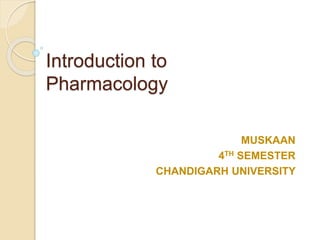
Introduction to pharmacology
- 2. DEFINITION OF PHARMACOLOGY Pharmacology is branch of biology that concerned with study of drug action and the effects of living organisms with drugs . Derived from Greek word pharmakon which means drugs This subject embodies drug composition and properties, interactions, toxicology, therapy, and medicinal uses such as application and ant pathogenic capabilities. Pharmacology is subdivided into two categories : 1. Pharmacodynamics : deals with chemical interactions with body/cell receptors 2. Pharmacokinetics : deals with the four stages of chemicals passing through the body: absorption, distribution, metabolism and excretion.
- 3. More specifically it is study of the interaction that occur between living organisms and chemicals that affect normal and abnormal; biochemical function Pharmacology is the study of the sources, uses, and mechanisms of action of drugs. That is what the body does to drugs (pharmacokinetics) and what drugs do to the body (pharmacodynamics) In contrast Pharmacy is health service profession concerned with application of principals learned from pharmacology in its clinical settings
- 4. Pharmacology is crucial for: •discovering new medicines to help fight diseases •improving the effectiveness of medicines •reducing unwanted side effects of medicines •understanding why individuals differ in the way they respond to certain drugs, and why some others cause addiction
- 5. DIVISION OF PHARMACOLOGY 1. Pharmacokinetics 2. Pharmacodynamics 3. Therapeutics 4. Chemotherapy 5. Toxicology 6. Clinical Pharmacology 7. Pharmacy 8. Pharmacognesy 9. Pharmacogenetics 10. Pharmacoeconomics 11. Pharmacoepidemiology 12. Comparative Pharmacology 13. Animal Pharmacology 14. Pharmacoeconomics 15. Posology
- 6. Therapeutics: The branch of pharmacology that deals with the art and science of treatment of disease. It is the application of pharmacological information together with the knowledge of disease, for the prevention and cure of the disease. Toxicology: branch of pharmacology which includes the study of adverse effects of drugs on the body. It deals with the symptoms, mechanisms, treatment and detection of poisoning caused by different chemical substances. The main criterion is the dose. Essential medicines are poisons in high doses and some poisons are essential medicines in low doses
- 7. Clinical Pharmacology: Clinical pharmacology is the scientific study of drugs in man. It includes pharmacokinetic and pharmacodynamic investigations in healthy or diseased individuals. It also includes the comparison with placebos, drugs in the market and surveillance programmers. Posology: Posology deals with the dosage of drugs. Example includes paracetamol given as one tablet of 500mg thrice a day. Neuropharmacology : study of effect of drug on central and pheripheral nervous system Pharmacogenetics: Branch of pharmacology dealing with the genetic variations that cause difference in drug response among individuals or population Chemotherapy: Chemotherapy refers to the treatment of diseases by chemicals that kill the cells, specially those of microorganisms and euplastic cells.
- 8. Pharamcogenomics: Pharmacogenomics is the broader application of genomic technologies to new drug discovery and further characterization of older drugs. Pharmacoepidemiology: Pharmacoepidemiology deals with the effects of drugs on a large population. The effects may be good or harmful. Pharmacognosy: Pharmacognosy is the identification of drugs by just seeing or smelling them. It is a crude method no longer used. Basically it deals with the drugs in crude or unprepared form and study of properties of drugs form natural sources or identification of new drugs obtained from natural sources. Comparative Pharmacology: Branch of pharmacology dealing with the comparison of one drug to another belonging to the same or another group
- 9. History of Pharmacology Pharmacology emerged as its own discipline in the 19th Century, branching off from research done in fields of science such as organic chemistry and physiology. Oswald Schmiedeberg who was born in what is now Latvia in 1838, is considered the father of pharmacology. His doctoral thesis was on the measurement of chloroform levels in blood, and he went on to become a professor of pharmacology at the University of Strasburg, where he ran an institute of pharmacology. There, he studied chloroform, which was used as an anesthetic, chloral hydrate, a sedative and hypnotic, and muscarine, a compound isolated from the mushroom Amanita muscaria that stimulates the parasympathetic nervous system and has been used to treat various diseases such as glaucoma.
- 10. In 1890, John Jacob Abel became the first pharmacology chair in the United States, at the University of Michigan. He later went to Johns Hopkins University in Baltimore. Abel was the first to isolate the hormone epinephrine from the adrenal gland, isolate histamine from the pituitary gland , and make pure crystalline insulin. Animals such as dogs, cats, pigeons, and frogs were used to test pharmacological substances. Humans were even used as test subjects. Sometimes they suffered through severe adverse effects from these substances, such as when the German pharmacist Friedrich Serturner and three of his friends had poisoning for several days from an alkaloid that Serturner had isolated from opium. This alkaloid was later named morphine, after the Ancient Greek god of sleep, Morpheus
- 11. Rudolf Buchheim : was a German pharmacologist born in Bautzen. In 1845 he earned his doctorate from the University of Leipzig and shortly after became an associate professor of pharmacology, dietetics. history of medicine and medical literature at the University of Dorpat. In 1849 he was chosen as a full professor of pharmacology. While at Dorpat he created the first pharmacological institute at that school. In 1867 he became professor of pharmacology and toxicology at the University of Giessen.
- 12. Early , Pharmacologist focused on natural substances mainly plants extract . Pharmacology developed in 19th century as a biomedical science that applied principals of scientific experimentation to therapeutical contexts Today Pharmacologists use genetics , molecular biology , biochemistry and other advanced tools to transform information about molecular mechanisms and targets into therapies directed against diseases , defects or pathogens and creates method for preventive care , diagnostic and ultimately personalized medicines